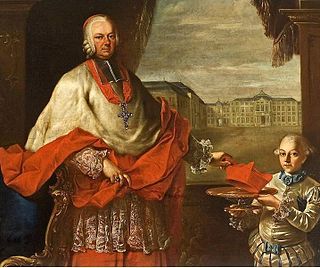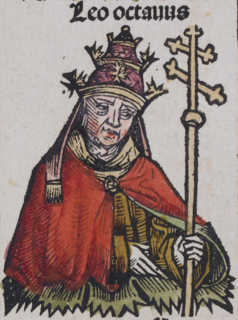Acts of the synod
The council met on 26 February 964, and it proceeded to hold three sessions. Present were John XII, sixteen Italian bishops (eleven of whom had been present at the synod of 963 which had deposed John), twelve cardinal-priests (most of whom had also been present, including the future Pope Benedict V), as well as a large number of the lower clergy present in Rome at the time. [1]
A bishop is an ordained, consecrated, or appointed member of the Christian clergy who is generally entrusted with a position of authority and oversight.

Pope Benedict V was Pope from 22 May to 23 June 964, in opposition to Pope Leo VIII. He was overthrown by emperor Otto I. His pontificate occurred at the end of a period known as the Saeculum obscurum.
John opened the first session, addressing the council in the following terms:
”You know, dearly beloved brethren, that by the power of the emperor I was expelled from my see for two months. I ask you then if, according to the canons, that can be called a synod which was held in my absence in my church on December 4 by the Emperor Otto and his archbishops and bishops?” [2]
When the synod declared that the previous synod was not carried out in accordance with canon law, the previous synod was condemned. Next, the actions of Sico, Bishop of Ostia, in rapidly ordaining and consecrating Leo VIII, were condemned, and he was asked to present himself at the third session for judgement. John then passed a sentence on Leo:
Canon law is a set of ordinances and regulations made by ecclesiastical authority, for the government of a Christian organization or church and its members. It is the internal ecclesiastical law, or operational policy, governing the Catholic Church, the Eastern Orthodox and Oriental Orthodox churches, and the individual national churches within the Anglican Communion. The way that such church law is legislated, interpreted and at times adjudicated varies widely among these three bodies of churches. In all three traditions, a canon was originally a rule adopted by a church council; these canons formed the foundation of canon law.
”By the authority of God Almighty, of the Princes of the Apostles, Peter and Paul, of the ecumenical councils and by the judgment of the Holy Spirit pronounced by us, may Leo, one of the employees of our curia, a neophyte, and a man who has broken his troth to us, be deprived of all clerical honours ; and if, hereafter, he should again attempt to sit on the apostolic throne, or perform any sacerdotal function, let him be anathematised along with his aiders and abettors, and, except in danger of death, not receive the sacred body of Our Lord Jesus Christ.” [3]
Then those who had been ordained by Leo were introduced before the synod, and were made to sign a paper that their ordinations were invalid. They were then reduced back to the rank they had held prior to Leo’s ordination.
In the second session, the two men who helped at the consecration of Leo, Benedictus, the Bishop of Silva Portus and the Bishop of Albano, both acknowledged their guilt in the uncanonical election of Leo. Then in the final session, as Bishop Sico had not presented himself, he was degraded from the rank of bishop. Finally, in a matter not related to the elevation of Leo, the synod also ruled that laypeople were forbidden to take a place on the sanctuary during the celebration of the Mass. [4]

The Diocese of Porto and Santa-Rufina is a suburbicarian diocese of the Holy Roman Church and a diocese of the Catholic Church in Italy. It was formed from the union of two suburbicarian sees of Rome.

Mass is a term used to describe the main eucharistic liturgical service in many forms of Western Christianity. The term Mass is commonly used in the Catholic Church and Anglican churches, as well as some Lutheran churches, Methodist, Western Rite Orthodox and Old Catholic churches.
After the synod, John XII ordered the mutilation of John, the Cardinal-Deacon, who had been one of his chief accusers at the synod which had condemned him, ordering him to lose his nose, tongue and two of his fingers. John also ordered that the Protoscriniar Azzo have his hand amputated, and for Otgar, Bishop of Speyer, to be scourged. [5]

The Bishop of Speyer is the Ordinary of the Roman Catholic Diocese of Speyer, which is a suffragan see of the Archdiocese of Bamberg. The diocese covers an area of 5,893 km². The current bishop is Karl-Heinz Wiesemann.
This page is based on this
Wikipedia article Text is available under the
CC BY-SA 4.0 license; additional terms may apply.
Images, videos and audio are available under their respective licenses.















